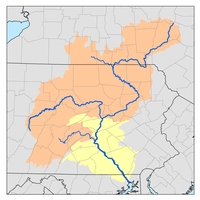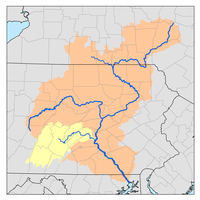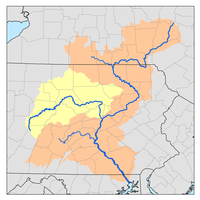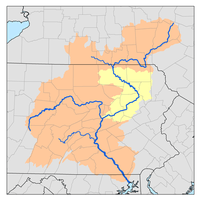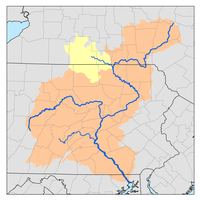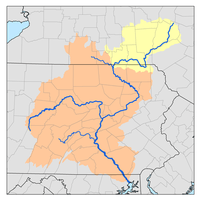Loyalsock Creek
Loyalsock Creek is a 64-mile-long (103 km)[1] tributary of the West Branch Susquehanna River located chiefly in Sullivan and Lycoming counties in Pennsylvania in the United States. As the crow flies, Lycoming County is about 130 miles (209 km) northwest of Philadelphia and 165 miles (266 km) east-northeast of Pittsburgh.
| Loyalsock Creek | |
|---|---|
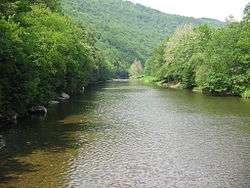 Loyalsock Creek from the Hillsgrove Covered Bridge | |
| Location | |
| Country | Pennsylvania, United States |
| Physical characteristics | |
| Source | |
| • location | Western Wyoming County |
| • elevation | 2,272 feet (693 m) |
| Mouth | |
• location | West Branch Susquehanna River, at Montoursville |
| Length | 64.3 miles (103.5 km) |
| Basin size | 495 square miles (1,280 km2) |
| Discharge | |
| • average | 766 cubic feet per second (21.7 m3/s) (for Loyalsockville |
Name
The name is a corruption of a word in the language of the local indigenous peoples meaning "middle creek" (the original was something like Lawi-sahquick). This refers to Loyalsock Creek's location between Lycoming Creek and Muncy Creek, with the mouths of each about 6 miles (10 km) up- and downstream of the mouth of the Loyalsock. Several important trails used by the local indigenous peoples ran along parts of the Loyalsock or crossed it. Two important villages of the local indigenous peoples were located on its banks, one of which, Ots-ton-wak-in, was the home to Madame Montour and her son Andrew Montour, and later became Montoursville.
Description
Loyalsock Creek is 64.3 miles (103.5 km) long.[1] The source is in western Wyoming County near the Sullivan County line, and its confluence with the West Branch Susquehanna River is at Montoursville. The area surrounding the confluence with the Susquehanna River has been flooded numerous times over the past decade, devastating many local homes and businesses.
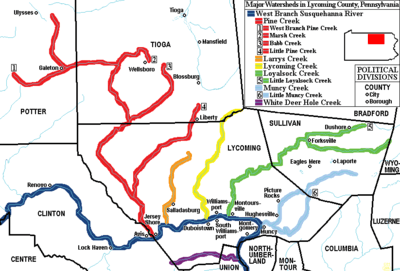
Its main tributary is Little Loyalsock Creek, which has its confluence at Forksville in Sullivan County. The names of Forksville and the surrounding Forks Township come from the fork of the creek there.
Pennsylvania receives the most acid rain of any state in the United States. Because Loyalsock Creek is in a sandstone, shale, conglomerate, and coal mountain region, it has a relatively low capacity to neutralize added acid. This makes it especially vulnerable to increased acidification from acid rain, which poses a long-term threat to the health of the plants and animals in the creek. [2]
Loyalsock Creek is used for trout fishing and whitewater kayaking, and the Loyalsock Trail which runs along it is an opportunity for hiking. Worlds End State Park is located on the Loyalsock in Sullivan County, near Forksville. Pennsylvania Route 87 runs the length of the valley, following the north fork after Forksville.
Floods
The Loyalsock has flooded many times, including major floods in 1866, 1889, 1894 and 1936. The floods of 1972, 1975, 1996 and 2011 each set the record for discharge (flow of water) and stage/gauge (height of the river’s surface). Hurricanes/tropical storms are the primary cause of floods, including Lee (2011)), Ivan (2004), Agnes (1972), and Eloise (1975). The second biggest flood in January 1996 was due to high rain and major snow melt.
The record flood of September 8, 2011 was due to a convergence of rare events, which included moisture from three tropical cyclones:
- The unusually heavy rains during the first four weeks of August.
- Three to five inches of rain from Hurricane Irene on August 28.
- The extreme rains far upstream (7+ inches) from remnants of Tropical Storm Lee.
- The enhanced rainfall on September 7–8 due to a moisture plume from Hurricane Katia.
The Loyalsock valley is deep and narrow, and the 435 sq. miles of drainage funnel water into the narrow valley, resulting in catastrophic level rise. Millions of dollars and six lives were lost in the 1996 and 2011 floods.[3]
Haystacks
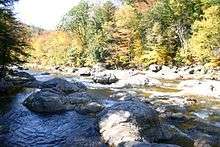
The Haystacks are mounds of sandstone that outcrop in Loyalsock Creek south of Dushore in Sullivan County. Geologically, they are a bed of quartz sandstone with an undulating upper surface, and are part of the Mississippian-Devonian Upper Huntley Mountain Formation.[4]
History
Village of Otstonwakin
Madame Montour's village of Otstonwakin or Ostuagy was a vitally important location during the settlement of what is now Lycoming County. She operated a trading post and supply depot, partly funded by the Pennsylvania Assembly. Her village at the mouth of Loyalsock Creek on the West Branch Susquehanna River, now part of Montoursville, was an important stopping point for the Moravian missionaries who were spreading the gospel throughout the wilderness of Pennsylvania during the 1740s. Count Zinzendorf, a missionary being guided by Conrad Weiser with the permission of Shikellamy, came to Otstonwakin in 1742.[5]
Madame Montour was known to be a friend of the British. She welcomed the white men who were beginning to migrate into the West Branch Susquehanna Valley. She also had a great amount of influence with the various Indian tribes that were feeling the pressure of colonial expansion. Madame Montour remained loyal to the British despite several attempts by the French to bring her over to their side. This was remarkable because the British colonial government sometimes went as long as a year without paying her for her services.
Rail transportation
Although lumbering was an important industry in the Loyalsock Creek watershed, railroads took little advantage of the creek valley below Forksville. One exception was the Susquehanna and Eagles Mere Railroad, which built down into Hillsgrove and along the creek as far as Ogdonia in 1902, before turning up Kettle Creek. It was removed in 1922. Above Forksville, the Williamsport and North Branch Railroad followed Mill Creek to reach the Loyalsock and followed it to a crossing at Ringdale. The line was built in 1893 and removed in 1938. About six miles (10 km) to the east, the town of Lopez is the largest settlement on the upper creek. Jennings Brothers Lumber Co. built a narrow-gauge logging line in the area in 1890, and another in 1891 up the creek into Wyoming County, to supply their sawmill at Lopez. In 1892, the Loyalsock Railroad crossed the creek here, building south to bring coal from the Bernice area southward to Harvey's Lake. It was promptly leased to the Lehigh Valley Railroad and became part of the Bowmans Creek Branch. At the same time, the Loyalsock Railroad also built a branch along the Loyalsock downstream from Lopez to Ellis Creek, where it turned south to reach a tannery at Thorndale. This branch was removed in 1898. However, Jennings Bros. continued to operate, standard-gauging their rail line about 1900 and building up the Loyalsock as far as Shumans Lake, where their line headed up Cold Run towards High Cobble and the Dutch Mountain area. The logging railroad was finally removed in 1905 when Jennings Bros. relocated to Maryland, but was partly resurrected in 1911. Stony Brook Lumber Co. used the old grade as far as Santee Run, then turned north towards Crane Swamp. This line was removed in 1916. Traffic gradually dwindled on the Lehigh Valley; their line south of Lopez was abandoned in 1939, and it was cut back to Bernice in 1944. Abandonment of the line to Lopez marked the end of rail traffic on the Loyalsock, except for the Reading Railroad crossing near its mouth at Montoursville.[6] The bridge there is now owned by the Lycoming Valley Railroad. The original Reading bridge was destroyed by flooding from Tropical Storm Lee in 2011 and removed. Its replacement was opened for service on August 13, 2014.
References
- U.S. Geological Survey. National Hydrography Dataset high-resolution flowline data. The National Map Archived 2012-04-05 at WebCite, accessed August 8, 2011
- "Acid Precipitation". Pennsylvania Fish and Boat Commission. Missing or empty
|url=(help) - "Lycoming County > Barbours Stream Gauge".
- The Haystacks, "Ricketts Folly," and The End of the World: Geology of the Glaciated Allegheny High Plateau, Sullivan, Luzerne, and Columbia Counties, Pennsylvania, 71st Annual Field Conference of Pennsylvania Geologists (field trip guide book), J. D. Inners, G. M. Fleeger, eds., 2006
- Meginness, John Franklin (1892). "CHAPTER CHAPTER XXXIV". History of Lycoming County, Pennsylvania: including its aboriginal history; the colonial and revolutionary periods; early settlement and subsequent growth; organization and civil administration; the legal and medical professions; internal improvement; past and present history of Williamsport; manufacturing and lumber interests; religious, educational, and social development; geology and agriculture; military record; sketches of boroughs, townships, and villages; portraits and biographies of pioneers and representative citizens, etc. etc (1st ed.). Chicago, IL: Brown, Runk & Co. ISBN 0-7884-0428-8. Retrieved 2007-03-07.
(Note: ISBN refers to Heritage Books July 1996 reprint. URL is to scan of 1892 version with some OCR typos).
- Taber, Thomas T., III (1987). Railroads of Pennsylvania Encyclopedia and Atlas. Thomas T. Taber III. ISBN 0-9603398-5-X.CS1 maint: multiple names: authors list (link)
External links
- U.S. Geological Survey: PA stream gaging stations
- The Columbia Gazetteer of North America, 2000 entry for Loyalsock Creek
- Chesapeake Bay Watershed Page on the Loyalsock Creek watershed from the source to Little Loyalsock Creek
- Chesapeake Bay Watershed Page on the Loyalsock Creek watershed from Little Loyalsock Creek to the mouth
- Official Lycoming County Map showing all townships, villages, boroughs, cities, county roads, rivers, creeks, and some streams
- History of Lycoming County Pennsylvania edited by John F. Meginness, ©1892 (copyright expired)
